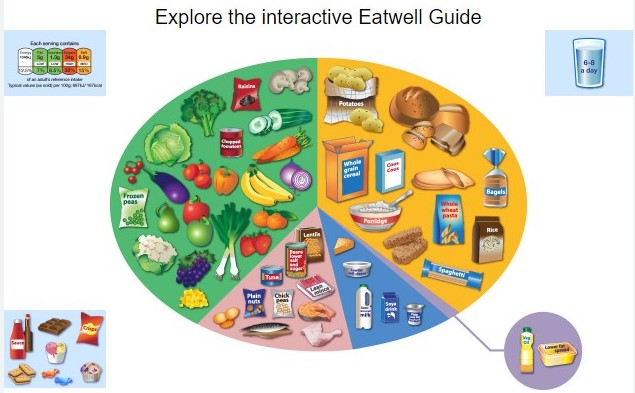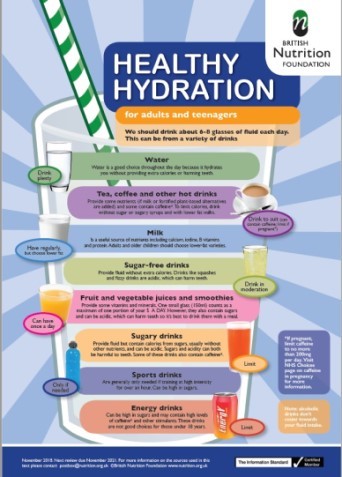Healthy Eating
Healthy eating for all ages
We all need to eat a good diet to keep us fuelled up with the energy we need for daily life, and the nutrients to help us fight infection and protect against health problems. But what exactly is a healthy diet?
The Department of Health has developed the ‘Eatwell’ plate to help:

The plate shows a diet that’s low in fat and high in fibre – is what we should all be aiming for:
- Plenty of fruit and vegetables. We should eat at least five portions of a variety of fruit and vegetables each day. Fresh, frozen, canned, dried and juices all count – but remember, fruit juice only counts towards one portion, no matter how many glasses you have.
- Plenty of potatoes, bread, rice, pasta and other starchy foods. We should aim to get these types of foods into every main meal and sometimes also in snacks (around three or four portions per day). Go for wholegrain options like wholemeal bread, brown rice and wholewheat pasta when you can, as these contain more fibre and nutrients
- Some milk and dairy foods. We should have two or three portions of these each day. This includes the milk on your cereal, a yoghurt, the cheese in your sandwich or a pudding made from milk like rice pudding or custard
- Some meat, fish, eggs, beans and other non-dairy sources of protein. We should include around two portions of these foods in our diet each day. These foods are usually eaten at meal times: the chicken from a Sunday roast, minced beef in a spaghetti bolognaise, the salmon in a fish pie, the eggs in an omelette and the lentils in a vegetarian curry
- Just a small amount of foods and drinks high in fat or sugar. It’s ok to have these foods every now and again, but too often can lead to weight gain, an unhealthy heart and tooth decay.
Tips
- It doesn’t matter if you don’t manage this sort of balance every single day – think about the whole week
- Try to eat lots of different foods. The bigger the range, the better your balance of nutrients will be
- You can have pudding in a healthy diet! Pack them full of fruit, some milk, dairy or starchy food and not too much fat and sugar.
- It’s not just about what children eat – how they eat is important too.
Why each food group is important
- Fruit and vegetables: for vitamin A and C, minerals like zinc and iron, and dietary fibre.
- Potatoes, bread, rice, pasta, breakfast cereal and other starchy foods: for energy, carbohydrate, fibre and B vitamins. Breakfast cereals are often fortified with extra nutrients, but stick to those with a low or medium sugar content and avoid the chocolate-covered varieties.
- Milk and dairy foods: for energy, protein, calcium and vitamin A.
- Meat, fish, eggs, beans and other non-dairy sources of protein: for protein, iron and zinc. Oily fish is part of this group and is important because it provides omega 3 fatty acids, vitamin A and vitamin D.
Healthy hydration for teenagers and adults
Water is essential for life and it is very important to get the right amount of fluid to be healthy.

Does it matter which drinks you choose?
All non-alcoholic drinks can contribute to hydration and some also contain essential vitamins and minerals. However, many drinks, such as soft drinks and fruit juices are high in sugars and so contain energy (calories). These calories contribute to your daily intake in the same way as those from the foods you eat, and higher consumption of sugary drinks has been associated with risk of type 2 diabetes and with weight gain in children. It is also important to look after your teeth, and consuming sugar-containing drinks too often can potentially harm your teeth, especially if you don’t brush teeth regularly with fluoride toothpaste. It is also important to be aware that some drinks are acidic (e.g. fruit juice and carbonated drinks) and that this may cause dental erosion (damage to tooth enamel) if they are consumed frequently.
- Drinking water is a great choice because it delivers fluid without calories or the sugars that can potentially damage teeth.
- Tea or coffee can also count towards your fluid intake. Although the caffeine found in tea and coffee can make you produce more urine, consuming moderate amounts does not appear to affect hydration. Pregnant women are advised to consume no more than 200mg or caffeine a day. This is equivalent to about two mugs of instant coffee or about two and a half mugs of tea. Other hot drinks such as herbal teas, hot chocolates and malted drinks can provide water, but as these drinks are sweetened with sugar it increases their calorie content. Sugar in hot drinks also increases their potential to damage teeth if good dental hygiene is not practiced.
- Milk contains lots of essential nutrients such as protein, some B vitamins, iodine and calcium, as well as being a source of water. However, it can also contain saturated fat and so it’s a good idea for adults and older children to choose semi-skimmed (less than 2% fat), 1% or skimmed milks. For children between the ages of one and two years, the recommended milk is whole milk. From two years onwards semi-skimmed milk can be introduced gradually. Skimmed and 1% milks are not suitable for children until they are at least five years old because they have less vitamin A and are lower in calories.
- Fruit juices and smoothies give you water plus some vitamins and minerals…. but fruit juices and smoothies contain sugar (and therefore calories) and can be acidic, so they can potentially harm teeth. Fruit juices and smoothies should be kept to a combined total of 150ml per day – this can count as a maximum of one portion of your 5 A DAY but not more than this. This is because they don’t contain the fibre that is found in whole fruits and vegetables.
- Sugary drinks, such as fizzy drinks, squashes, juice drinks and flavoured waters can contain a lot of sugar and generally provide few nutrients – this adds to your calorie intake and the sugar can potentially damage teeth if the drinks are consumed frequently. It’s a good idea to limit or avoid consumption of sugary drinks and swap them for diet, sugar free or no added sugar versions.
- Sports drinks typically contain some carbohydrate and electrolytes (generally sodium but sometimes others). Adding these elements can help the fluid from the drink be absorbed into the body more quickly, replace some of the sodium that may be lost when sweating and will also provide some energy (calories). However, these are only really necessary when you are training at a high level, e.g. in endurance sports where sweat losses are higher, and you may need some extra energy. If training at a lower level, then water is likely to be sufficient to replace fluid losses and any sodium lost in sweat will be replaced when foods are eaten. The carbohydrate in the drink will add calories, which may not be needed and will be counterproductive if part of the reason for being active is for weight control. The sugars in sports drinks can also increase the risk of tooth decay.
- Energy drinks can be high in sugars and also contain caffeine and other stimulants. They can contain high levels of caffeine and so are not suitable for children.
- Food – it may be a surprise to learn that we get on average 20% of our total water intake from food! Some foods have a high-water content, especially fruits and vegetables, which are usually more than 80% water. Foods like soups and stews, which have lots of water added during preparation, also are a source of water. So, food can provide extra water, on top of the 6-8 glasses of fluid you should drink a day.